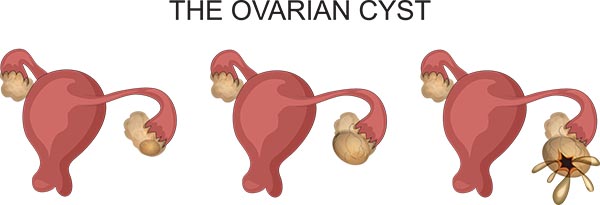Ovarian Cysts Ultrasound and Treatment
Ovarian cysts are fluid-filled sacs that develop in or on the ovary. Ovarian cysts occur commonly in women of all ages. Some women with ovarian cysts have pain or pelvic pressure, while others have no symptoms. Irregular menstrual periods are not usually related to an ovarian cyst.
Ovarian Cysts Treatment in Brooklyn
Ovarian cysts are often detected during a pelvic exam. A pelvis ultrasound can allow the doctor to see the cyst with sound waves and help determine whether it is comprised of fluid, solid tissue, or a mixture of the two.
Fortunately, most ovarian cysts do not require surgical removal and are not caused by cancer. Cysts can vary in size from less than one centimeter (one-half inch) to greater than 10 centimeters (4 inches). This topic discusses the various causes of ovarian cysts, how ovarian cysts are diagnosed, and what follow up testing and/or treatment might be recommended.

Premenopausal Women
For premenopausal women, the most common causes of ovarian cysts include:
- Ovulation – “Functional” ovarian cysts develop when a follicle (sac) grows, but does not rupture to release the egg. These cysts usually resolve without treatment.
- Dermoid cysts – Dermoid cysts (teratomas) are one of the most common types of cysts found in women between age 20 and 40 years. A dermoid cyst is made up ovarian germ cells (germ cells are reproductive cells, eg, eggs) and can contain teeth, hair, or fat. Most dermoid cysts are benign, but rarely, they can be cancerous.
- Polycystic ovary syndrome (PCOS) – Women with PCOS may have many small cysts. These cysts do not need to be removed or treated with medication, but women with PCOS may need treatment for other PCOS problems, such as irregular menstrual periods.
- Endometriosis – Women with endometriosis can develop a type of ovarian cyst called an endometrioma, or “chocolate cyst.”
- Pregnancy – An ovarian cyst normally develops in early pregnancy, to help support the pregnancy until the placenta forms. In some cases, the cyst stays on the ovary until later in the pregnancy.
- Severe pelvic infections – Severe pelvic infections may spread to involve the ovaries and fallopian tubes. As a result, pus-filled cysts form close to the ovaries and/or fallopian tubes.
- Non-cancerous growths
- Cancer – Cancer is a relatively uncommon cause of ovarian cysts in premenopausal women; less than 1 percent of new growths on or near the ovary are related to ovarian cancer.
Postmenopausal Women
In women who have stopped having menstrual periods, the most common causes of ovarian cysts include:
In postmenopausal women, new growths on or around the ovary are somewhat more likely to be caused by cancer than in premenopausal women.
Request Your Consultation Now
Request a consultation at BellaDonna MD. Ready to get started? Call us today or fill out the form below.
BellaDona Medical P.C © 2022. All Rights Reserved. Privacy Policy
